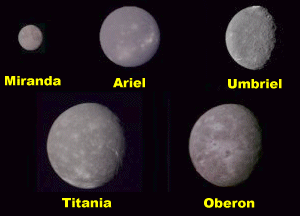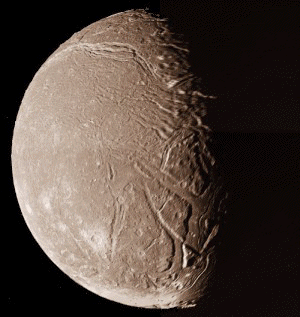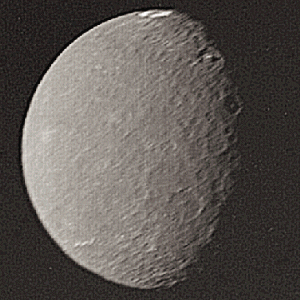
NASA's Voyager 2 spacecraft flew closely past distant Uranus, the seventh planet from the Sun, in January 1986.
At its closest, the spacecraft came within 81,500 kilometers (50,600 miles) of Uranus's cloudtops on Jan. 24, 1986.
Voyager 2's images of the five largest moons around Uranus revealed complex surfaces indicative of varying geologic pasts. The cameras also detected 10 previously unseen moons.
Voyager 2 obtained clear, high-resolution images of each of the five large moons of Uranus known before the encounter: Miranda, Ariel, Umbriel, Titania and Oberon. The two largest, Titania and Oberon, are about 1,600 kilometers (1,000 miles) in diameter, roughly half the size of Earth's Moon. The smallest, Miranda, is only 500 kilometers (300 miles) across, or just one-seventh the lunar size.
The 10 new moons discovered by Voyager bring the total number of known Uranian satellites to 21. The largest of the newly detected moons, named Puck, is about 150 kilometers (about 90 miles) in diameter, or larger than most asteroids.
Preliminary analysis shows that the five large moons are ice-rock conglomerates like the satellites of Saturn. The large Uranian moons appear, in fact, to be about 50 percent water ice, 20 percent carbon- and nitrogen-based materials, and 30 percent rock. Their surfaces, almost uniformly dark gray incolor, display varying degrees of geologic history. Very ancient, heavily cratered surfaces are apparent on some of the moons, while others show strong evidence of internal geologic activity.
Uranus has 20 named moons plus 1 recently discovered one which as yet has not been given an official name; it thus has the most known moons of any of the planets.
| Satellite or Moon | Distance From Uranus (km) |
Radius (km) |
|---|---|---|
| Cordelia | 50 | 13 |
| Ophelia | 54 | 16 |
| Bianca | 59 | 22 |
| Cressida | 62 | 33 |
| Desdemona | 63 | 29 |
| Juliet | 64 | 42 |
| Portia | 66 | 55 |
| Rosalind | 70 | 27 |
| Belinda | 75 | 34 |
| 1986U10 | 76 | 40 |
| Puck | 86 | 77 |
| Miranda | 130 | 236 |
| Ariel | 191 | 579 |
| Umbriel | 266 | 585 |
| Titania | 436 | 789 |
| Oberon | 583 | 761 |
| Caliban | 7169 | 40 |
| Stephano | 7948 | 15 |
| Sycorax | 12213 | 80 |
| Prospero | 16568 | 20 |
| Setebos | 17681 | 20 |
Miranda

Photo Composit
Miranda is a bizarre world which surely had a tempestuous past. The innermost of the larger Uranian moons, Miranda is almost 300 miles in diameter and was discovered only 50 years ago (February 16, 1948) by the renown American planetary astronomer Gerard Kuiper. Examined very closely by the Voyager 2 spacecraft in 1986, this dark and distant world turned out to be quite a surprise. Miranda was found to display a unique, bewildering variety of terrain leading some to suggest that it has been fractured up to 5 times during its evolution. Along with the famous "chevron" feature, the bright V-shaped area just above center, this composite of the highest resolution images of Miranda shows wild juxtapositions of ridges and valleys, older cratered and younger smooth surfaces, and shadowy canyons perhaps 12 miles deep. The large crater (below center) is the 15 mile wide crater Alonso.
Ariel

What formed Ariel's valleys? This question presented itself when Voyager 2 passed this satellite of Uranus in January 1986. Speculation includes that heating caused by the ancient tides of Uranus caused moonquakes and massive shifting of the moon's surface. In any event, a huge network of sunken valleys was found to cover this frozen moon, and some unknown material now coats the bottoms of many of these channels. Ariel is the second closest to Uranus outside of Miranda, and is composed of roughly half water ice and half rock. Ariel was discovered by William Lassell in 1851.
Umbriel

Why is Umbriel so dark? This dark moon reflects only half the light of other Uranus' moons such as Ariel. And what is that bright ring at the top? Unfortunately, nobody yet knows. These questions presented themselves when Voyager 2 passed this satellite of Uranus in January 1986. Voyager found an old surface with unusually large craters, and determined Umbriel's composition to be about half ice and half rock. Umbriel is the fourth largest and third most distant of Uranus' five large moons. Umbriel was discovered in 1851 by William Lassell.
Titania

Titania's tortured terrain is a mix of valleys and craters. NASA's interplanetary robot spacecraft Voyager 2 passed this moon of Uranus in 1986 and took the above photograph. The photograph was then transmitted back to earth by radio. The valleys of Titania resemble those on Ariel indicate that Titania underwent some unknown tumultuous resurfacing event in its distant past. Although Titania is Uranus' largest moon, it is still much smaller than Triton - the largest moon of Uranus' sister planet Neptune. Titania is essentially a large dirty iceball that orbits Uranus - it is composed of about half water-ice and half rock. Titania was discovered by William Hershel in 1787.
Oberon

Oberon is the most distant and second largest moon of Uranus. Discovered by William Herschel in 1787, the properties of the world remained relatively unknown until the robot spacecraft Voyager 2 passed it during its flyby of Uranus in January 1986. Compared to Uranus' moons Ariel, Titania, and Miranda, Oberon is heavily cratered, and in this way resembles Umbriel. Like all of Uranus' large moons, Oberon is composed of roughly half ice and half rock. Note that Oberon has at least one large mountain, visible on the limb at the lower left, that rises 6 km off the surface.
Back To Main Menu
Use the "BACK" button on your Browser to return to the previous page.